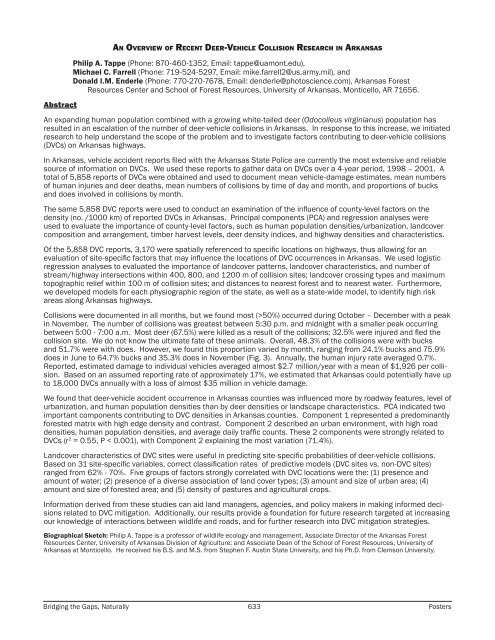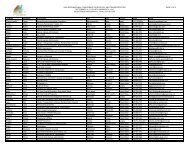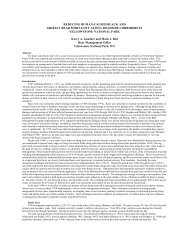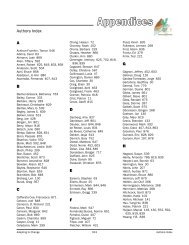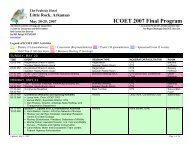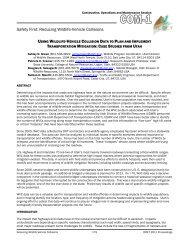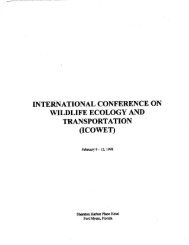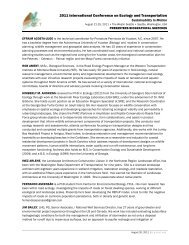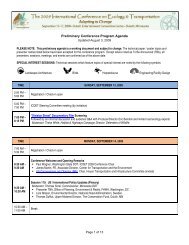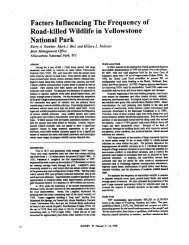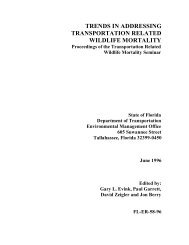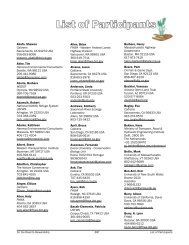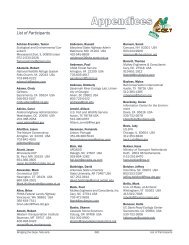Poster Sessions, pages 567-640 - ICOET
Poster Sessions, pages 567-640 - ICOET
Poster Sessions, pages 567-640 - ICOET
You also want an ePaper? Increase the reach of your titles
YUMPU automatically turns print PDFs into web optimized ePapers that Google loves.
Abstract<br />
An Overview of Recent Deer-Vehicle Collision Research in Arkansas<br />
Philip A. Tappe (Phone: 870-460-1352, Email: tappe@uamont.edu),<br />
Michael C. Farrell (Phone: 719-524-5297, Email: mike.farrell2@us.army.mil), and<br />
Donald I.M. Enderle (Phone: 770-270-7678, Email: denderle@photoscience.com), Arkansas Forest<br />
Resources Center and School of Forest Resources, University of Arkansas, Monticello, AR 71656.<br />
An expanding human population combined with a growing white-tailed deer (Odocoileus virginianus) population has<br />
resulted in an escalation of the number of deer-vehicle collisions in Arkansas. In response to this increase, we initiated<br />
research to help understand the scope of the problem and to investigate factors contributing to deer-vehicle collisions<br />
(DVCs) on Arkansas highways.<br />
In Arkansas, vehicle accident reports filed with the Arkansas State Police are currently the most extensive and reliable<br />
source of information on DVCs. We used these reports to gather data on DVCs over a 4-year period, 1998 – 2001. A<br />
total of 5,858 reports of DVCs were obtained and used to document mean vehicle-damage estimates, mean numbers<br />
of human injuries and deer deaths, mean numbers of collisions by time of day and month, and proportions of bucks<br />
and does involved in collisions by month.<br />
The same 5,858 DVC reports were used to conduct an examination of the influence of county-level factors on the<br />
density (no. /1000 km) of reported DVCs in Arkansas. Principal components (PCA) and regression analyses were<br />
used to evaluate the importance of county-level factors, such as human population densities/urbanization, landcover<br />
composition and arrangement, timber harvest levels, deer density indices, and highway densities and characteristics.<br />
Of the 5,858 DVC reports, 3,170 were spatially referenced to specific locations on highways, thus allowing for an<br />
evaluation of site-specific factors that may influence the locations of DVC occurrences in Arkansas. We used logistic<br />
regression analyses to evaluated the importance of landcover patterns, landcover characteristics, and number of<br />
stream/highway intersections within 400, 800, and 1200 m of collision sites; landcover crossing types and maximum<br />
topographic relief within 100 m of collision sites; and distances to nearest forest and to nearest water. Furthermore,<br />
we developed models for each physiographic region of the state, as well as a state-wide model, to identify high risk<br />
areas along Arkansas highways.<br />
Collisions were documented in all months, but we found most (>50%) occurred during October – December with a peak<br />
in November. The number of collisions was greatest between 5:30 p.m. and midnight with a smaller peak occurring<br />
between 5:00 - 7:00 a.m. Most deer (67.5%) were killed as a result of the collisions; 32.5% were injured and fled the<br />
collision site. We do not know the ultimate fate of these animals. Overall, 48.3% of the collisions were with bucks<br />
and 51.7% were with does. However, we found this proportion varied by month, ranging from 24.1% bucks and 75.9%<br />
does in June to 64.7% bucks and 35.3% does in November (Fig. 3). Annually, the human injury rate averaged 0.7%.<br />
Reported, estimated damage to individual vehicles averaged almost $2.7 million/year with a mean of $1,926 per collision.<br />
Based on an assumed reporting rate of approximately 17%, we estimated that Arkansas could potentially have up<br />
to 18,000 DVCs annually with a loss of almost $35 million in vehicle damage.<br />
We found that deer-vehicle accident occurrence in Arkansas counties was influenced more by roadway features, level of<br />
urbanization, and human population densities than by deer densities or landscape characteristics. PCA indicated two<br />
important components contributing to DVC densities in Arkansas counties. Component 1 represented a predominantly<br />
forested matrix with high edge density and contrast. Component 2 described an urban environment, with high road<br />
densities, human population densities, and average daily traffic counts. These 2 components were strongly related to<br />
DVCs (r 2 = 0.55, P < 0.001), with Component 2 explaining the most variation (71.4%).<br />
Landcover characteristics of DVC sites were useful in predicting site-specific probabilities of deer-vehicle collisions.<br />
Based on 31 site-specific variables, correct classification rates of predictive models (DVC sites vs. non-DVC sites)<br />
ranged from 62% - 70%. Five groups of factors strongly correlated with DVC locations were the: (1) presence and<br />
amount of water; (2) presence of a diverse association of land cover types; (3) amount and size of urban area; (4)<br />
amount and size of forested area; and (5) density of pastures and agricultural crops.<br />
Information derived from these studies can aid land managers, agencies, and policy makers in making informed decisions<br />
related to DVC mitigation. Additionally, our results provide a foundation for future research targeted at increasing<br />
our knowledge of interactions between wildlife and roads, and for further research into DVC mitigation strategies.<br />
Biographical Sketch: Philip A. Tappe is a professor of wildlife ecology and management, Associate Director of the Arkansas Forest<br />
Resources Center, University of Arkansas Division of Agriculture; and Associate Dean of the School of Forest Resources, University of<br />
Arkansas at Monticello. He received his B.S. and M.S. from Stephen F. Austin State University, and his Ph.D. from Clemson University.<br />
Bridging the Gaps, Naturally 633 <strong>Poster</strong>s


